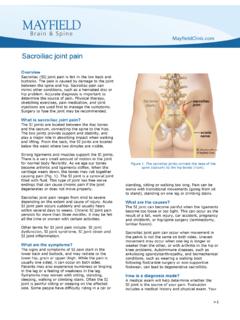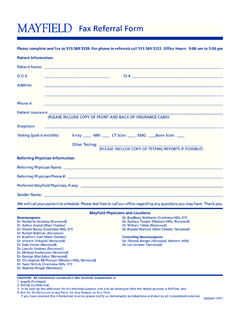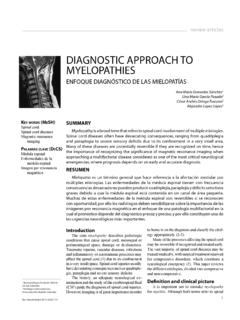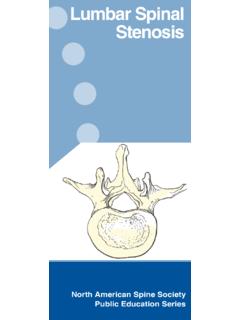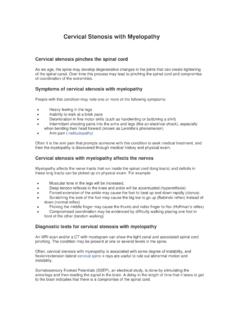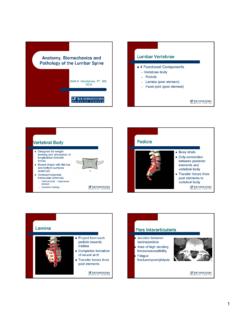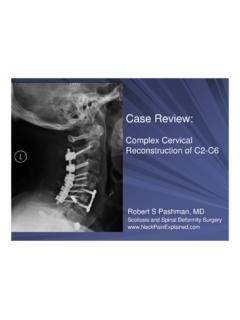Transcription of Degenerative Disc Disease (spondylosis) - Mayfield Clinic
1 > 1 Overview Degenerative disc Disease is a condition caused by the breakdown of the discs that separate the spine bones. As you age, the spine begins to show signs of wear and tear as the discs dry out and shrink. These age-related changes can lead to arthritis, disc herniation, or spinal stenosis . Pressure on the spinal nerves may cause pain. Physical therapy, self-care, medication, and spinal injections are used to manage symptoms. Surgery is an option if the pain is chronic. Anatomy of vertebrae & discs Your spine is made of a column of bones called vertebrae. Between each vertebra is a gel-filled disc that acts as a shock absorber, preventing the bones from rubbing together.
2 Discs are designed like a radial car tire. The tough outer wall, called the annulus, has criss-crossing fibrous bands, much like a tire tread. These bands attach to each vertebra bone. Inside the disc is a gel-filled center called the nucleus, much like a tire tube (Fig. 1). What is Degenerative disc Disease ? Degenerative disc Disease (also called spondylosis ) is a general term used to describe aging changes that can occur along any area of the spine (cervical, thoracic, lumbar), but is most common in the lumbar area. It s not actually a Disease , but rather a condition in which your discs degenerate, or lose their flexibility and height to cushion the spine. Discs don t have a good blood supply, so once injured they can t repair themselves easily.
3 These age-related changes include (Fig. 2): Discs dry out and shrink discs are made of about 80% water. As you get older they slowly lose water and flexibility, which puts more stress on the annulus. Small tears occur in the annulus sometimes the gel-like nucleus pushes through a tear in the wall and touches nearby nerves. This material has inflammatory proteins that can irritate nerves and cause pain. These tears also affect tiny nerves in the annulus and cause discogenic pain with small micro-motion instability of the disc . Over time the proteins dry up and the discs become stiffer. In many people this results in less pain by the time they are in their sixties. disc space gets smaller due to the loss of water in the discs, the distance between vertebrae begin to collapse, which is why we get shorter as we age.
4 Bone spurs grow without the discs holding apart the vertebrae, they can rub on each other and cause abnormal bone growths. spinal canal narrows the stresses of all the above changes causes the ligaments and facet joints to enlarge (hypertrophy) as they try to compensate and spread the load over a larger Degenerative disc Disease ( spondylosis ) 2. Degenerative disc Figure 1. Drawing of a normal disc showing the gel-filled nucleus surrounded by annulus rings of cartilage fibers. Figure 2. Drawing of a Degenerative disc that is dried out and collapsed, reducing the disc space between vertebrae. Bone spurs and tears in the annulus may develop which can lead to spinal stenosis and disc herniation.
5 1. Normal disc > 2 area. This overgrowth causes the spinal canal to narrow, which can compress the spinal cord and nerves and result in pain (see spinal stenosis ). What are the symptoms? The symptoms of a Degenerative disc vary from person to person. Many people with deterioration have no pain, while others may experience pain so intense that it interferes with daily activities. Interestingly, even though this condition affects people starting in their twenties or thirties, people in their sixties are less likely to have back pain caused by deteriorated discs. Pain often starts in one of three ways: (1) a major injury followed by sudden and unexpected pain, (2) a trivial injury followed by sudden back pain, and (3) pain that starts gradually and gets progressively worse.
6 Usually, the pain begins in the lower back, and may be felt in one or both of your legs and buttocks (sciatica). It s often described as pressure or burning pain. You may also feel numbness or tingling in your leg and foot, which usually is not a cause for concern unless you have weakness in your leg muscles. You may have chronic underlying pain that is a nagging annoyance, and occasional episodes of intense muscle pain from time to time. These episodes last from a few days to a few months. Sitting usually causes the most pain because in this position your discs have more weight on them. Activities such as bending or twisting usually make your pain worse, and lying down tends to relieve the pain. You may actually feel better if you walk or run rather than sit or stand for too long.
7 Many people diagnosed in their thirties wonder if their Degenerative disc will cause even more pain by the time they are in their sixties. But by the time you are 60, your discs may have dried out to the point that they cause less pain. What are the causes? In addition to age and injury, arthritis and osteoporosis contribute to Degenerative disc Disease . Most abnormalities relating to DDD can be seen on an MRI an imaging scan that shows the parts of your spine in clear detail. While a large portion of people with back pain have abnormalities confirmed by MRI, studies on healthy young adults have shown that as many as 30% of people without pain also have abnormalities seen on an MRI scan. (1) It s not known why some people have pain and others don t, but various factors contribute to disc degeneration including: genetic, environmental, autoimmune, inflammatory, and traumatic factors in combinations and ways that aren t yet understood.
8 Who is affected? This condition usually affects young adults or middle-aged people who lead active lifestyles and are in otherwise good heath. Studies have shown that people who smoke are at greater risk for developing Degenerative disc Disease , as are people who work in certain occupations. People with DDD are more likely to have family members who also have the condition (2, 3, 4). How is a diagnosis made? When you first experience pain, consult your family doctor. Your doctor will take a complete medical history to understand your symptoms, any prior injuries or conditions, and determine whether any lifestyle habits are causing the pain. Next a physical exam is performed to determine the source of the pain and test for any muscle weakness or numbness.
9 Your doctor may order one or more of the following imaging studies: X-ray, MRI scan, discogram, myelogram, or CT scan to identify a tumor, herniated disc , or other conditions that compress the nerve roots. Based on the results, you may be referred to a neurologist, orthopedist, or neurosurgeon for treatment. What treatments are available? While disc degeneration can t be reversed, there is evidence that exercise, lifestyle changes and careful management of your back pain can contribute to better quality of life. Nonsurgical treatment is the first step. If conservative therapies fail to help you manage and control the painful symptoms, your doctor may recommend surgery. However, the long-term effectiveness of surgery for Degenerative disc Disease as opposed to natural history, conservative treatment, or placebo has yet to be studied.
10 (5) Nonsurgical treatments Nonsurgical treatment for a Degenerative disc may include medication, rest, physical therapy, home exercises, hydrotherapy, chiropractic, and pain management. Self care: Using correct posture (see Posture for a Healthy Back) and keeping your spine in alignment are the most important things you can do for your back. You may need to make adjustments to your daily standing, sitting, and sleeping habits and learn proper ways to lift and bend (see Self Care for Neck & Back Pain). Your workspace may need to be rearranged to keep your spine from being under stress. Stress is the number one obstacle to pain control. Pain increases when you are tense and stressed. > 3 Relaxation exercises are one way of reclaiming control of your body.
